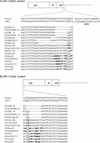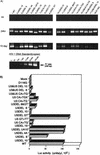Specific and independent recognition of U3 and U5 att sites by human immunodeficiency virus type 1 integrase in vivo
- PMID: 9733892
- PMCID: PMC110226
- DOI: 10.1128/JVI.72.10.8396-8402.1998
Specific and independent recognition of U3 and U5 att sites by human immunodeficiency virus type 1 integrase in vivo
Abstract
The retroviral attachment (att) sites at viral DNA ends are cis-acting regions essential for proviral integration. To investigate the sequence features of att important for human immunodeficiency virus type 1 (HIV-1) integration in vivo, we generated a series of 25 att mutants of HIV-1 by mutagenesis of the U3, U5, or both boundaries of att. Our results indicated that the terminal 11 or 12 bp of viral DNA are sufficient for specific recognition by HIV-1 integrase (IN) and suggested that IN might recognize each att site independently in vivo.
Figures





Similar articles
-
Activity of recombinant HIV-1 integrase on mini-HIV DNA.Nucleic Acids Res. 1999 May 15;27(10):2202-10. doi: 10.1093/nar/27.10.2202. Nucleic Acids Res. 1999. PMID: 10219094 Free PMC article.
-
Genetic analysis of human immunodeficiency virus type 1 integrase and the U3 att site: unusual phenotype of mutants in the zinc finger-like domain.J Virol. 1995 Nov;69(11):6687-96. doi: 10.1128/JVI.69.11.6687-6696.1995. J Virol. 1995. PMID: 7474078 Free PMC article.
-
Both substrate and target oligonucleotide sequences affect in vitro integration mediated by human immunodeficiency virus type 1 integrase protein produced in Saccharomyces cerevisiae.J Virol. 1992 Apr;66(4):2359-68. doi: 10.1128/JVI.66.4.2359-2368.1992. J Virol. 1992. PMID: 1548767 Free PMC article.
-
Site-specific integration of retroviral DNA in human cells using fusion proteins consisting of human immunodeficiency virus type 1 integrase and the designed polydactyl zinc-finger protein E2C.Methods. 2009 Apr;47(4):269-76. doi: 10.1016/j.ymeth.2009.01.001. Epub 2009 Jan 30. Methods. 2009. PMID: 19186211 Free PMC article. Review.
-
Integrase and integration: biochemical activities of HIV-1 integrase.Retrovirology. 2008 Dec 17;5:114. doi: 10.1186/1742-4690-5-114. Retrovirology. 2008. PMID: 19091057 Free PMC article. Review.
Cited by
-
Integration-deficient lentiviral vectors: a slow coming of age.Mol Ther. 2009 Aug;17(8):1316-32. doi: 10.1038/mt.2009.122. Epub 2009 Jun 2. Mol Ther. 2009. PMID: 19491821 Free PMC article. Review.
-
Asymmetric processing of human immunodeficiency virus type 1 cDNA in vivo: implications for functional end coupling during the chemical steps of DNA transposition.Mol Cell Biol. 2001 Oct;21(20):6758-67. doi: 10.1128/MCB.21.20.6758-6767.2001. Mol Cell Biol. 2001. PMID: 11564861 Free PMC article.
-
Molecular Interactions between HIV-1 integrase and the two viral DNA ends within the synaptic complex that mediates concerted integration.J Mol Biol. 2009 May 29;389(1):183-98. doi: 10.1016/j.jmb.2009.04.007. Epub 2009 Apr 9. J Mol Biol. 2009. PMID: 19362096 Free PMC article.
-
SiRNA-induced mutation in HIV-1 polypurine tract region and its influence on viral fitness.PLoS One. 2015 Apr 10;10(4):e0122953. doi: 10.1371/journal.pone.0122953. eCollection 2015. PLoS One. 2015. PMID: 25860884 Free PMC article.
-
Mutations in the U5 region adjacent to the primer binding site affect tRNA cleavage by human immunodeficiency virus type 1 reverse transcriptase in vivo.J Virol. 2008 Jan;82(2):719-27. doi: 10.1128/JVI.02611-06. Epub 2007 Nov 7. J Virol. 2008. PMID: 17989171 Free PMC article.
References
Publication types
MeSH terms
Substances
LinkOut - more resources
Full Text Sources
Other Literature Sources

